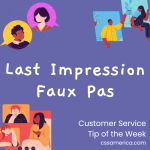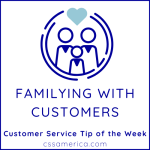Einstein once said “We can’t solve problems by using the same kind of thinking we used when we created them.”
With that in mind, think about your organization’s (or your own) current issues. . .
Your bank is losing accounts. Your team is losing season ticket holders. Your municipality is getting more complaints than ever, or maybe your hospital’s patient satisfaction ratings are dropping.
You personally are seeing the quality of your work decrease; your co-workers aren’t as responsive to your requests as normal; you’re feeling less organized, or you’re getting more criticism than you’re used to hearing.
You want to find a solution to these issues, but – using Einstein’s quote – you need to approach the solution with different thinking, different questions, a different process than you used to create the problem.
Now none of us intend to “create the problem,” but we do typically create a process, a program, a philosophy, or a way of prioritizing. We do have a method to use to gain input, to make decisions, or to execute a plan.
So here are some considerations for how to solve problems with a different kind of thinking. If you don’t use these currently, consider them:
- Have a customer advisory group help you in better understanding the problem, identifying potential solutions, or “testing” programs/products/processes prior to implementation.
- Ask front-line employees what issues they’re hearing and how the organization can more quickly identify chronic problems and develop solutions.
- Look at how different industries deal with problems similar to yours. What could colleges learn about retention strategies from sports teams? What could hospitals learn from manufacturers about continuous improvement? What could a bank learn from a high-end retailer about the customer experience?
- Ask an employee of some business you patronize how they always seem to be in a great mood or how they’re able to respond so quickly to requests.
- Ask a vendor how they maintain such a consistently high level of quality.
- Identify different “hats” to wear in analyzing a problem, and get a group of people to look at the same problem wearing these pre-defined hats. For example, have all members of the group analyze the problem using their “Data Hat” (They all look at the problem, its root causes, and solutions based on what the data’s conveying). Other examples could include: People Hat, Process Hat, Communications Hat, Materials Hat, Motivation Hat, etc.
When problems arise, find new ways to overcome old issues.





















